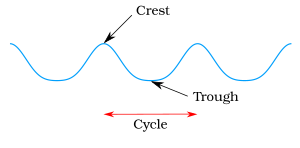Crest (physics) facts for kids
A crest is the highest point of a wave. Imagine a water wave moving across the ocean; the crest is the very top of that wave. It's the spot where the wave reaches its greatest height or upward push in its journey.
The opposite of a crest is a trough. A trough is the lowest point of a wave. So, while the crest is the peak, the trough is the valley.
When two waves meet, their crests and troughs can interact in interesting ways. If the crest of one wave meets the crest of another wave, and they are moving together, they can combine to make an even bigger wave. This is called constructive interference. It means they add up! But if the crest of one wave meets the trough of another wave, they can cancel each other out, making the wave smaller or even flat. This is called destructive interference.
Contents
What is a Wave?
A wave is a way that energy moves through something, like water or air. Think of dropping a pebble into a pond. Ripples spread out from where it landed. These ripples are waves. They carry energy away from the pebble. But the water itself doesn't travel with the wave; it mostly moves up and down or back and forth. Waves are all around us, from the sound we hear to the light we see.
Parts of a Wave
Every wave has different parts that help us understand it.
Crest and Trough
As we learned, the crest is the highest point of a wave. It's like the top of a hill. The trough is the lowest point, like the bottom of a valley. These two points are key to describing any wave.
Wavelength
The wavelength is the distance between two nearby crests. It can also be the distance between two nearby troughs. Imagine measuring from the top of one wave to the top of the next wave. That distance is the wavelength. It tells us how long a single wave cycle is.
Amplitude
The amplitude of a wave is how tall it is from its middle resting position to a crest (or how deep it is to a trough). A wave with a big amplitude is a strong wave, like a loud sound or a bright light. A small amplitude means a weaker wave, like a quiet sound or a dim light.
Frequency
Frequency tells us how many waves pass by a certain point in a set amount of time. If many waves pass by quickly, the frequency is high. If they pass slowly, the frequency is low. For example, high-frequency sound waves have a high pitch, while low-frequency sound waves have a low pitch.
How Waves Interact
Waves don't always travel alone. They often meet and interact with other waves.
Constructive Interference
When two waves meet and their crests line up, they add together. This makes a bigger wave. This is called constructive interference. It's like two people pushing a swing at the same time, making it go higher.
Destructive Interference
When the crest of one wave meets the trough of another wave, they can cancel each other out. This makes the wave smaller or even flat. This is called destructive interference. It's like two people pushing a swing in opposite directions, making it stop.
Crests and Troughs in Everyday Life
You can find crests and troughs in many places:
- Ocean Waves: The most obvious example! When you're at the beach, you see the crests of the waves crash on the shore.
- Sound Waves: Sound travels as waves through the air. The crests are where the air is most compressed, and the troughs are where it's most spread out.
- Light Waves: Light also travels in waves. The crests and troughs of light waves are related to their brightness and color.
Related pages
See also
 In Spanish: Cresta (ola) para niños
In Spanish: Cresta (ola) para niños


